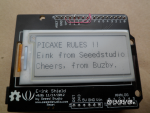Buzby
Senior Member
Hi All,
It's took me a while, but here is the Seeedstudio E-ink shield running on a PICAXE AXE401.

Notice no power connections ?. E-ink holds the display after power off.
Notice the patch wires at the top ?. That's because the board is not fully Arduino compatible.
Want to know it was done ?. Code is below. Not tidy yet, and very slow.
Cheers,
Buzby
View attachment Eink_4.bas
Data here : http://www.seeedstudio.com/depot/eink-display-shield-p-1374.html?cPath=132_134
It's took me a while, but here is the Seeedstudio E-ink shield running on a PICAXE AXE401.

Notice no power connections ?. E-ink holds the display after power off.
Notice the patch wires at the top ?. That's because the board is not fully Arduino compatible.
Want to know it was done ?. Code is below. Not tidy yet, and very slow.
Cheers,
Buzby
View attachment Eink_4.bas
Data here : http://www.seeedstudio.com/depot/eink-display-shield-p-1374.html?cPath=132_134
Last edited:
